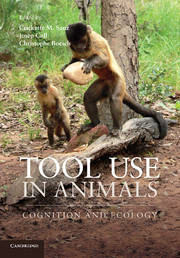Book contents
- Frontmatter
- Contents
- List of contributors
- Part I Cognition of tool use
- 1 Three ingredients for becoming a creative tool user
- 2 Ecology and cognition of tool use in chimpanzees
- 3 Chimpanzees plan their tool use
- Part II Comparative cognition
- Part III Ecology and culture
- Part IV Archaeological perspectives
- Index
- References
3 - Chimpanzees plan their tool use
from Part I - Cognition of tool use
Published online by Cambridge University Press: 05 March 2013
- Frontmatter
- Contents
- List of contributors
- Part I Cognition of tool use
- 1 Three ingredients for becoming a creative tool user
- 2 Ecology and cognition of tool use in chimpanzees
- 3 Chimpanzees plan their tool use
- Part II Comparative cognition
- Part III Ecology and culture
- Part IV Archaeological perspectives
- Index
- References
Summary
Introduction
To a cognitive psychologist, chimpanzee tool use is exciting because of the opportunity it brings to examine how apes deal with a range of challenging situations that in humans would invoke planning. By planning it is meant a special kind of problem solving in which an appropriate course of action for the immediate or distant future is worked out by means of mental computation with brain representations of past or present situations (Miller et al., 1960). These include: a working representation of the current situation that presents a problem; episodic memories of specific past instances and events; and semantic knowledge about how things work or how people behave.
Because a tool is not itself a goal-object, but has meaning and functionality only in regard to achieving a goal, problem solving with tools often makes more of the planning process “visible” than is normally the case (Seed & Byrne, 2010). Because a tool often must be selected to meet specific criteria in order to work, or – more telling still – may have to be made from specific raw materials in a particular way, getting an appropriate tool becomes an extra stage in the planning process. Thus, to approach a cognitive understanding of animal planning, studying tool use is by no means the only approach, but it is certainly a good one. Historically, however, understanding cognition has not been the major driving force in the study of tool use in great apes in primatology: that stemmed instead from anthropology, a subject with a very different agenda.
- Type
- Chapter
- Information
- Tool Use in AnimalsCognition and Ecology, pp. 48 - 64Publisher: Cambridge University PressPrint publication year: 2013
References
- 19
- Cited by



